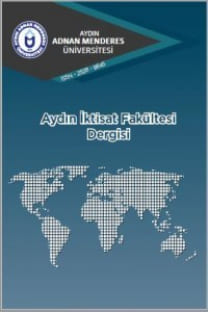LÜBNAN'IN YÖNETSEL YAPISI
Lübnan, uzun yıllar yaşadığı iç karışıklıkları ve yönetsel sorunları günümüzde de zaman zaman yaşamaya devam etmektedir. Bu sorunların temelinde ülkenin çok dinli ve çok kültürlü yapısının önemli bir etkisi bulunmaktadır. Ülkenin içi işlerine müdahale etmek isteyen ülkeler için uygun zemini sağlayan bu çeşitlilikler ise yüzyılı aşkın süredir ülkenin temel sorunu olmaya devam etmektedir. Bu çalışmanın amacı, dini ve kültürel farklılıklar temelinde Lübnan yönetsel yapısının nasıl şekillendiği ve mevcut durumunun ortaya konulmasıdır. Lübnan Anayasası ve literatür incelemeleri doğrultusunda, ülkedeki yasama ve yürütme erklerinin paylaşımının dini ve mezhepsel dağılıma göre yapıldığı ancak cumhurbaşkanının yetkilerinin geniş tutulduğu ve inanç grupları arasında zaman zaman dış müdahalelerin de etkisiyle güç ve yetki mücadelesinin devam ettiği görülmektedir. Demokratik geleneklerin yeterince yerleşmediği toplumlarda demokrasiyi sağlamak adına yapılan bu tür bir temsil anlayışının başarılı olamadığı ve ülkeyi dış güçlerin müdahalesine açık hale getirdiği sonucuna ulaşılmaktadır.
Anahtar Kelimeler:
lübnan, lübnan anayasası, lübnan yönetsel yapısı
LEBANON'S ADMİNİSTRATİVE STRUCTURE
Lebanon continues to experience internal turmoil and administrative problems that it has been experiencing for many years. The multi-religious and multi-cultural structure of the country has an important effect on the basis of these problems. This diversity, which provides the appropriate ground for countries that want to intervene in the internal affairs of the country, has been the main problem of the country for more than a century. The aim of this study is to reveal how the administrative structure of Lebanon was shaped on the basis of religious and cultural differences and its current situation. In line with the Lebanese Constitution and literature reviews, it has been revealed that the sharing of legislative and executive powers in the country is based on religious and sectarian distribution. However, it is seen that the powers of the president are kept wide and the struggle for power and authority continues between belief groups with the effect of external interventions from time to time. It is concluded that such an understanding of representation, which is made to ensure democracy in societies where democratic traditions are not sufficiently established, has not been successful and makes the country open to the intervention of foreign powers.
___
- Andırırbu, R. (2020) “Bütünleşemeyen Lübnan’da Temel Siyasi Aktör Olarak Dini Gruplar”, Bellek Uluslararası Tarih ve Kültür Araştırmaları Dergisi, 2(2): 190-212.
- Andırırbu, R. (2020) “Lübnan'da Toplumsal Yapının Siyasete Etkisi”, Yüksek Lisans Tezi, Kırıkkale Üniversitesi, Kırıkkale.
- Apprioual, A. (2014) “Lebanon’s Political Stalemate: The Failure of the Sectarian Regime”, The Arab Uprisings and Social Rights: Asian Migrant Workers in Lebanon.
- Aydın, İ. S. (2009) “Lübnan Ülke Raporu” TC Başbakanlık Dış Ticaret Müsteşarlığı İhracatı Geliştirme Etüt Merkezi.
- Bağlıoğlu, A. (2008) “Lübnan’ın Tarihsel Dokusu ve Yönetim Anlayışındaki Mezhebi Etkiler”, Fırat Üniversitesi İlahiyat Fakültesi Dergisi, 13(1): 13-36.
- Banders, C. J. (2016) “Institutional İsomorphism Between Lebanon and Europe: Myth Or Reality Of A Legal Alignment?”, Doktora Tezi, Beyrut Amerikan Üniversitesi, Lübnan.
- Bogaards, M. (2019) “Formal And İnformal Consociational İnstitutions: A Comparison Of The National Pact And The Taif Agreement İn Lebanon”, Nationalism and Ethnic Politics, 25(1): 27-42.
- Caldwell, D. K. (2009) “The Hegemony Of Sectarianism In Lebanon”, Doktora Tezi, Villanova Üniversitesi, Pensilvanya.
- CIA (2018). Factbook. (07.06.2021), https://www.cia.gov/the-world-factbook/countries/lebanon/#people-and-society
- Constitution Of Lebanon, (1926) With Its Amendments 1990, https://www.wipo.int/edocs/lexdocs/laws/en/lb/lb018en (01.06.2021).
- Danış, F. (2016) “2006 Savaşı’ndan Günümüze Lübnan’daki Siyasi Tablo”, Ülke Analizi, İNSANMER. https://www.insamer.com/tr/2006-savasindan-gunumuze-lubnandaki-siyasi-tablo_459.html (07.06.2021)
- Farha, M. (2015) “Stumbling Blocks to the Secularization of Personal Status Laws in the Lebanese Republic (1926-2013)”, Arab Law Quarterly, 29(1): 31-55.
- Gaspard, T. (2003) “A Political Economy Of Lebanon, 1948-2002: The Limits Of Laissez-Faire”, Brill Publishing.
- Hitti, P. K. (1965) “Short History Of The Lebanon”, 1st Edition, New York, Macmillan International Higher Education.
- Hudson, M. C. (1968) “The Precarious Republic: Modernization İn Lebanon”, New York, Random House.
- Hudson, M. C. (1976) “The Lebanese Crisis: The Limits Of Consociational Democracy”, Journal of Palestine Studies, 5(3-4): 109-122.
- Karam, K. (2012) “The Taif Agreement”, Accord, 24: 36-41.
- Kor, Z. T. (2009) “Ortadoğu'nun Aynası Lübnan”, İstanbul: İHH Araştırma ve Yayınlar Birimi.
- Köprülü, N. ve Ebrem, İ. S. (2013) “Lübnan’da Çoklu Güç Paylaşımı ve Ortaklıkçı Demokrasi Zemininin Arap Ayaklanmaları Sonrası Geleceği”, Akademik Orta Doğu, 8(1): 1-24.
- Köse, T. (2006) “Lübnan’da İstikrar Arayışları”, SETA Lübnan Raporu, Ankara.
- Madadi, A. O. (2019) “Lübnan Siyasi Modernleşmesi”, https://ankara.academia.edu/AbdullahOmidMadadi, (02.06.2021).
- Overview Of The Lebanese System https://www.presidency.gov.lb/English/LebaneseSystem/Pages/OverviewOfTheLebaneseSystem.aspx (01.10. 2021).
- Özkoç, Ö. (2006) “Kronik: Lübnan Savaşı Üzerine”, Ankara Üniversitesi SBF Dergisi, 61(3).
- Saliba, I. (2010) “Lebanon: Constitutional Law And The Political Rights Of Religious Communities”, Law Library of Congress, Global Legal Research Center.
- Salibi, K. S. (1971) “The Lebanese Identity”, Journal of Contemporary History, 6(1): 76-86.
- Stewart J. (2012) “Countries in Crisis- Lebanon”, USA, Rourke Publishing LLC.
- T.C. Ticaret Bakanlığı (2020). Lübnan Ülke Profili, (01.06.2021). https://ticaret.gov.tr/data/5ef635e013b8762b38e2ffc0/L%C3%9CBNAN%20%C3%BClke%20profili%20270421.pdf
- Taflıoğlu, M. (2016) “Lübnan Anayasal Düzeninde Egemenlik Dağılımı”, Sosyoekonomi, 24(28): 31-42.
- The Taif Agreement, (1989) https://www.un.int/lebanon/sites/www.un.int/files/Lebanon/the_taif_agreement_english_version_.pdf, (08.06.2021).
- Toubia, K., Djulancic, L. ve Gaier, M. (2019) “Government Formation in Lebanon – Key Aspects of Internal Obstacles”, Konrad-Adenauer-Stiftung e. V., (1-12).
- Traboulsi, F. (2012) “A History Of Modern Lebanon”, 2nd Edition, London, Pluto Press.
- Weber, A. S. ve Hamlaoui, S. (Eds.). (2018) “E-Learning in the Middle East and North Africa (MENA) Region”, Springer.
- ISSN: 2528-9845
- Yayın Aralığı: Yılda 2 Sayı
- Başlangıç: 2016
- Yayıncı: Adnan Menderes Üniversitesi
